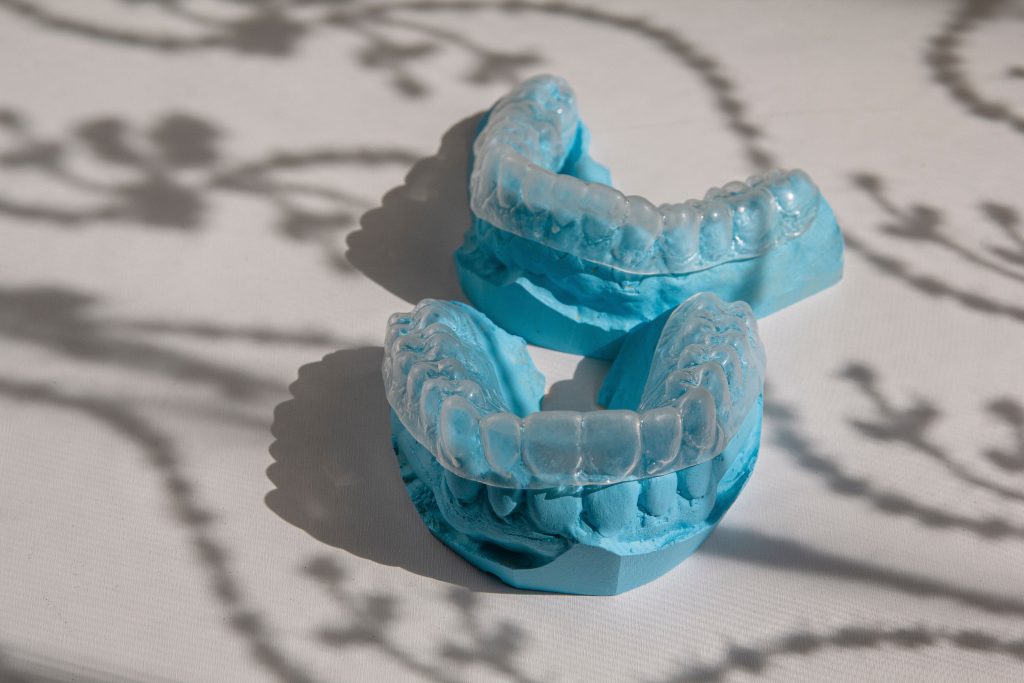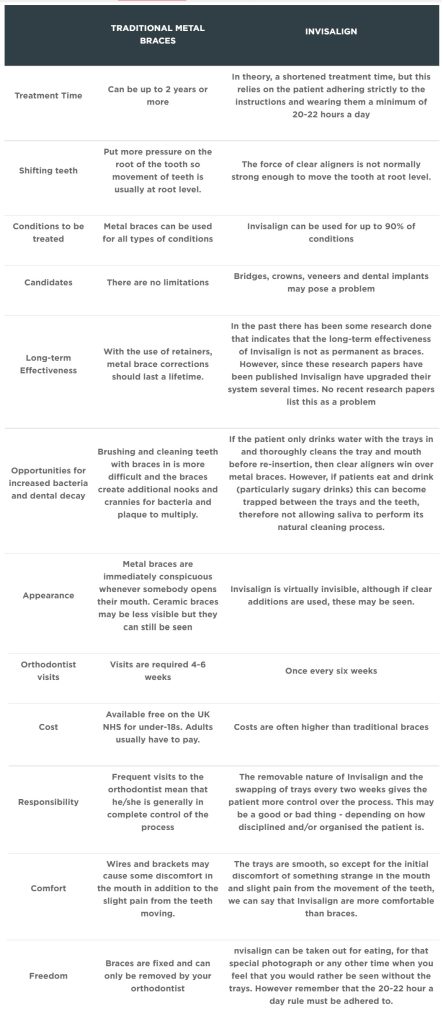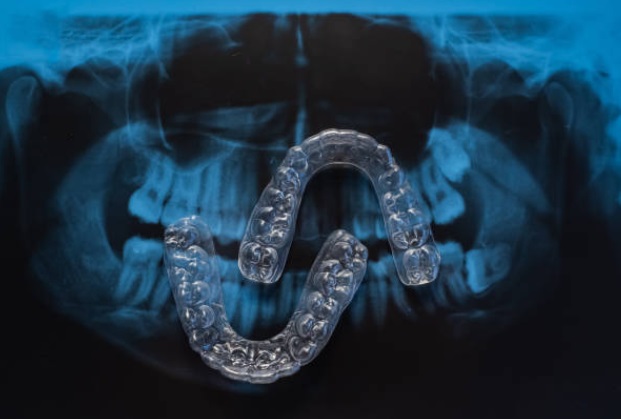
Show the clinics offering Invisalign
What is Invisalign treatment?
Invisalign is a brand name for an American company that manufactures invisible braces or trays. They replace the familiar metal braces used to correct malocclusions such as overbites and crooked teeth, and the way these traditional braces gently move teeth into place in the mouth. Invisalign replaces traditional braces that are worn on your teeth for several years.

You could be forgiven for thinking that Invisalign was the predecessor of this product.In fact, the first tooth aligner, or “tooth positioner,” was invented in 1945 by American orthodontist Harold D. Kessling. These aligners were custom made, made of rubber, and acted like mouthguards. When worn alongside traditional metal braces, the process of repositioning the teeth was much quicker.Throughout the 20th century there have been various changes to the concept by different people, but only in the 1990s , dental splints became widespread.
Zia Chishti, a student at Stanford University, was disillusioned with the level of discomfort she had endured with standard metal braces. In 1997, he and his friend Kelsey Worth invented the world’s first completely transparent dental splint system. Together they founded Align Technology, a company that manufactures these braces under the Invisalign brand name. For the first time, adults can straighten their teeth with discreet, almost invisible appliances. No more metal clips and wires filling your mouth. The concept was simple. The patient was given a series of aligners that differed slightly from the previous aligner, gradually moving the teeth into the correct position. Invisalign uses current technology to replicate a series of computer-aided models obtained from dental impressions. This product appeared on his market in 1999 and for a long time did not have a clear competitor.
How does Invisalign work?
The Invisalign process is very simple and highly technical. A dentist or orthodontist scans your teeth and uses a computer program to create a complete treatment plan. This includes a description of what the tooth will look like after treatment, so changes and additions can be made at this stage. Once everything is decided, the system creates your personal splint. As with metal braces, your dentist/orthodontist may need to treat your teeth before your first Invisalign aligners arrive. This may involve filing some teeth to ensure there is enough space in the mouth for the teeth to move.
 The average wait time for the first bowl is about 4 weeks, but it can be longer. Each aligner is tailored to the patient’s teeth and adjusted by applying pressure to specific points. A new splint should normally be used every two weeks for her, but your orthodontist will advise the optimal duration of each splint to suit your individual treatment plan. Teeth typically move about 1/10 mm with each splint. After Spoon 1, Spoon 2 has a slightly different shape, which shifts the required teeth by an additional 1/10 mm. Your dentist/orthodontist will want to check in on your progress every 4-6 weeks. At each consultation he offers the next set of trays. The duration of treatment depends on what kind of correction is needed and how much the teeth need to be moved. The minimum duration of treatment is 9 months, but it can last up to 18 months or longer. In some cases, additional tips are attached to the aligners to help move the teeth.
The average wait time for the first bowl is about 4 weeks, but it can be longer. Each aligner is tailored to the patient’s teeth and adjusted by applying pressure to specific points. A new splint should normally be used every two weeks for her, but your orthodontist will advise the optimal duration of each splint to suit your individual treatment plan. Teeth typically move about 1/10 mm with each splint. After Spoon 1, Spoon 2 has a slightly different shape, which shifts the required teeth by an additional 1/10 mm. Your dentist/orthodontist will want to check in on your progress every 4-6 weeks. At each consultation he offers the next set of trays. The duration of treatment depends on what kind of correction is needed and how much the teeth need to be moved. The minimum duration of treatment is 9 months, but it can last up to 18 months or longer. In some cases, additional tips are attached to the aligners to help move the teeth.
Invisalign vs braces
Are braces or Invisalign better? Unfortunately, this question is not easy to answer. Dentists have differing opinions about which is most effective. It depends on the type of condition that needs to be addressed, the severity of the condition, and the patient’s lifestyle and preferences. A recent article in the BMC Oral Health Journal by Yunyan Ke, Yanfei Zhu, and Min Zhu concluded: Clear aligners had the advantage of segmented tooth movement and reduced treatment time, but were not as effective as braces in establishing proper occlusal contact, controlling tooth torque and retention. Only an orthodontist can accurately assess the condition of your teeth and determine which orthodontics are appropriate and which treatments are best. However, the table below presents the most important facts about the strengths and weaknesses of braces compared to Invisalign.

Invisalign - effects
 In some cases, you may see results from your Invisalign treatment within 10-12 weeks. The most crooked or misaligned teeth are usually the last to move, so it can take longer to get the most dramatic results. How long the Invisalign effect lasts depends on the type of Invisalign you use. H. Full, Lite, i7, or Express, and modifications made. If a patient is dissatisfied with the results of Invisalign, it is often because they have worn the Invisalign for a minimal amount of time each day. There may be a final “adjustment phase” of As with regular braces, once treatment is complete, patients should wear retainers to keep their teeth from moving back into place.
In some cases, you may see results from your Invisalign treatment within 10-12 weeks. The most crooked or misaligned teeth are usually the last to move, so it can take longer to get the most dramatic results. How long the Invisalign effect lasts depends on the type of Invisalign you use. H. Full, Lite, i7, or Express, and modifications made. If a patient is dissatisfied with the results of Invisalign, it is often because they have worn the Invisalign for a minimal amount of time each day. There may be a final “adjustment phase” of As with regular braces, once treatment is complete, patients should wear retainers to keep their teeth from moving back into place.
Invisalign Costs – How much does Invisalign cost?
 As with any braces or aligners procedure, frequent visits to the orthodontist are an important part of the treatment to make sure it is working as it should. An important factor. This means that you have to pay a percentage of the total cost of various appointments at your dental office/clinic. Because of this, the cost of Invisalign can vary greatly between orthodontists. So it might be worth doing some research, but when you factor in time and travel costs, a cheap orthodontist 20 miles away is a “more expensive” orthodontist a mile away from your home or work. Be aware that it may end up costing you more than a doctor.
As with any braces or aligners procedure, frequent visits to the orthodontist are an important part of the treatment to make sure it is working as it should. An important factor. This means that you have to pay a percentage of the total cost of various appointments at your dental office/clinic. Because of this, the cost of Invisalign can vary greatly between orthodontists. So it might be worth doing some research, but when you factor in time and travel costs, a cheap orthodontist 20 miles away is a “more expensive” orthodontist a mile away from your home or work. Be aware that it may end up costing you more than a doctor.
Orthodontists typically do not give a confirmed quote until they have scanned/x-rayed your teeth and determined the work required and the extent of treatment. Accurate identification is very important. Are the costs of all scheduled appointments included? Will I need dental work before my Invisalign treatment? If so, is that included in the quote? What about retainers? Are these included in the cost? What is the cost if a touch-up is required?
Due to the varying complexity of Invisalign treatments, it is difficult to give an exact cost for Invisalign treatments.Invisalign itself estimates guide prices for Invisalign Full treatments at £2,500 to £5,500 for an aligner course. However, you can find Invisalign Express for just £1295, Invisalign i7 for £1200 to £3000 and Invisalign Lite for £1800 to £3500. Your orthodontist can tell you if one of the cheaper versions is suitable for your desired dental treatment. Many dental offices and clinics offer simple payment plans.

Invisalign in Poland
Polish Invisalign is becoming more and more popular. Well-equipped clinics, widely spoken English, and low fares and frequent flights from many European cities make it the country of choice for many people to get dental care. . The cost of Invisalign in Poland is generally lower than UK prices. Prices start around £1000 and top around £4000. Be sure to ask the clinic how often you will be scheduled for testing. With frequent flight schedules from many airports within the UK (as well as other European cities), it is more cost-effective to use different dental clinics in larger cities such as Warsaw, Krakow, Wroclaw and Gdansk. Some may find it expensive. .

